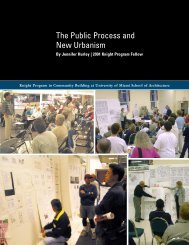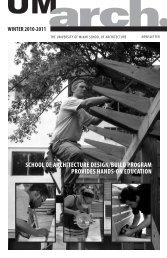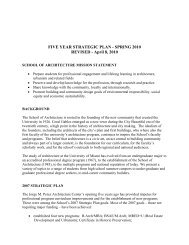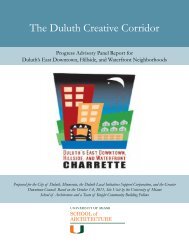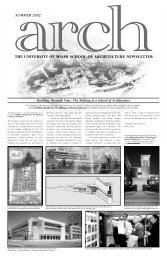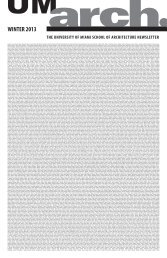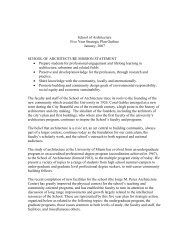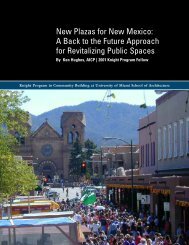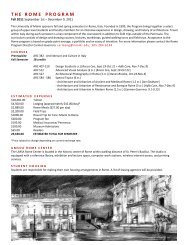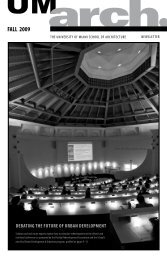The Disappearing Rowhouse Neighborhoods of Baltimore and ...
The Disappearing Rowhouse Neighborhoods of Baltimore and ...
The Disappearing Rowhouse Neighborhoods of Baltimore and ...
You also want an ePaper? Increase the reach of your titles
YUMPU automatically turns print PDFs into web optimized ePapers that Google loves.
<strong>The</strong> <strong>Disappearing</strong> <strong>Rowhouse</strong><br />
<strong>Neighborhoods</strong> <strong>of</strong> <strong>Baltimore</strong><br />
<strong>and</strong> Philadelphia:<br />
What’s an Urbanist to Do<br />
By Philip Langdon | 2001 Knight Program Fellow<br />
Knight Program in Community Building at University <strong>of</strong> Miami School <strong>of</strong> Architecture
1<br />
Contents<br />
2<br />
Abstract<br />
3<br />
Full Report<br />
27<br />
Plans<br />
Cover<br />
A partial block <strong>of</strong> ab<strong>and</strong>oned rowhouses <strong>of</strong>f Cecil B. Moore Avenue in North Philadelphia.
2<br />
<strong>The</strong> <strong>Disappearing</strong> <strong>Rowhouse</strong> <strong>Neighborhoods</strong> <strong>of</strong><br />
<strong>Baltimore</strong> <strong>and</strong> Philadelphia: What’s an Urbanist to Do<br />
By Philip Langdon | 2001 Knight Program Fellow<br />
Bio<br />
Philip Langdon is a widely<br />
published freelance journalist<br />
<strong>and</strong> author <strong>of</strong> books including<br />
A Better Place to Live:<br />
Reshaping the American<br />
Suburb (University <strong>of</strong><br />
Massachusetts Press, 1994)<br />
<strong>and</strong> Urban Excellence (Van<br />
Nostr<strong>and</strong> Reinhold, 1990).<br />
He is also senior editor <strong>of</strong> the<br />
national design <strong>and</strong> planning<br />
newsletter New Urban News.<br />
Abstract<br />
This paper examines the responses <strong>of</strong> <strong>Baltimore</strong> <strong>and</strong> Philadelphia to the<br />
deterioration or ab<strong>and</strong>onment <strong>of</strong> low-income rowhouse neighborhoods. Strategies<br />
<strong>and</strong> tactics that are discussed include: renovating rundown rowhouses with<br />
public subsidies; combining narrow rowhouses to make wider, more marketable<br />
homes; demolishing individual rowhouses; transferring cleared lots to adjacent<br />
homeowners; demolishing entire blocks <strong>of</strong> unmarketable small rowhouses along<br />
alleys; creating neighborhood parks where alley houses stood; converting vacant<br />
l<strong>and</strong> into community gardens; building new rowhouses with modern amenities;<br />
<strong>and</strong> “de-densifying” the city by constructing detached or semi-detached houses.<br />
This paper examines why many <strong>of</strong> these approaches have frequently failed.<br />
Among the points made: 1) Spot rehab has <strong>of</strong>ten been ineffective because as<br />
some houses were improved, others fell into ab<strong>and</strong>onment, leaving the neighborhoods<br />
just as deteriorated as they had been at the start. 2) New parks in<br />
former alley areas received little natural surveillance, <strong>and</strong> tended to become<br />
neglected <strong>and</strong> vulnerable to crime. 3) New rowhouses with parking in front<br />
sacrifice the traditional semi-enclosed feeling <strong>of</strong> the streets. 4) Semi-detached<br />
houses (known in Philadelphia as “twins”) rob the streets <strong>of</strong> definition if they<br />
are not properly sited. 5) Combining side-by-side units can save blocks <strong>of</strong> rowhouses,<br />
but the cost is too high to do this extensively.<br />
Some <strong>of</strong> the more successful approaches have been: 1) Transfer <strong>of</strong> ab<strong>and</strong>oned<br />
lots to next-door neighbors. 2) Community gardens on vacant l<strong>and</strong>. Gardens<br />
<strong>and</strong> maintenance <strong>of</strong> vacant l<strong>and</strong> have created a more orderly, hopeful atmosphere<br />
<strong>and</strong> brought out neighborhood volunteers. 3) Establishment <strong>of</strong> small parks<br />
surrounded by the fronts <strong>of</strong> houses, or private outdoor spaces closely supervised<br />
from the backs <strong>of</strong> houses, has created valuable urban amenities in some neighborhoods.<br />
4) An architectural competition in Philadelphia that produced interesting<br />
ideas for shallow rowhouses wrapping around secluded interior l<strong>and</strong>scapes.<br />
<strong>The</strong>se rowhouses would reduce neighborhood density, yet define the streets.<br />
<strong>The</strong> author argues that cities should be more strategic about demolition,<br />
should have different policies for neighborhoods with varying conditions, should<br />
focus on bolstering transitional neighborhoods, <strong>and</strong> should try to revitalize the<br />
city as a whole by attracting middle- to upper-income residents. Middle-income<br />
people can be attracted to areas with good prospects for revival, such as those<br />
near downtowns, employment centers, universities, hospitals, <strong>and</strong> amenities.<br />
Administrative approaches such as a clearinghouse for information about vacant<br />
properties may reduce the volume <strong>of</strong> derelict l<strong>and</strong> <strong>and</strong> buildings.
3<br />
<strong>The</strong> <strong>Disappearing</strong> <strong>Rowhouse</strong> <strong>Neighborhoods</strong> <strong>of</strong><br />
<strong>Baltimore</strong> <strong>and</strong> Philadelphia: What’s an Urbanist to Do<br />
By Philip Langdon | 2001 Knight Program Fellow<br />
Photo<br />
A partial block <strong>of</strong> ab<strong>and</strong>oned<br />
rowhouses <strong>of</strong>f Cecil B. Moore<br />
Avenue in North Philadelphia.<br />
In few urban areas <strong>of</strong> the United States is neighborhood ab<strong>and</strong>onment now<br />
more acute than in the rowhouse sections <strong>of</strong> Philadelphia <strong>and</strong> <strong>Baltimore</strong>. In <strong>Baltimore</strong>,<br />
a city famous for block after block <strong>of</strong> rowhouses with white marble steps, ab<strong>and</strong>onment<br />
has run rampant. More than 13,000 <strong>of</strong> <strong>Baltimore</strong>’s residential structures sit ab<strong>and</strong>oned,<br />
95 percent <strong>of</strong> them rowhouses. 1 In Philadelphia nearly 25,000 rowhouses are vacant<br />
<strong>and</strong> unlikely to be reoccupied. Sixty percent have been empty for more than a decade.<br />
How did this problem develop What remedies have been tried How have those<br />
efforts fared What approaches now seem in order This paper<br />
attempts to answer those questions <strong>and</strong> to point toward strategies<br />
that can help cities address the problem <strong>of</strong> neighborhood<br />
ab<strong>and</strong>onment. Research for this report included visits, under<br />
the auspices <strong>of</strong> the Knight Program in Community Building at<br />
the University <strong>of</strong> Miami School <strong>of</strong> Architecture, to many<br />
<strong>Baltimore</strong> <strong>and</strong> Philadelphia neighborhoods <strong>and</strong> interviews in<br />
those two cities with a variety <strong>of</strong> people, ranging from architects<br />
to city planners to leaders <strong>of</strong> neighborhood community development<br />
corporations.<br />
Origins <strong>of</strong> <strong>Rowhouse</strong> <strong>Neighborhoods</strong><br />
In Maryl<strong>and</strong>, southern Pennsylvania, <strong>and</strong> other sections <strong>of</strong> the Eastern seaboard,<br />
the rowhouse has a long history. In both the “greene country towne” that William<br />
Penn laid out along the Delaware River in 1682 <strong>and</strong> in <strong>Baltimore</strong>, founded on<br />
Chesapeake Bay in 1729, rows <strong>of</strong> buildings sharing sidewalls with their neighbors<br />
were the main form <strong>of</strong> urban housing in the 1800s. Tight-knit development, with<br />
buildings st<strong>and</strong>ing shoulder to shoulder, remained the dominant pattern in those<br />
two cities into the 20th century.<br />
<strong>The</strong> rowhouse form was compact enough form a conveniently walkable community<br />
<strong>and</strong> variable enough to accommodate a broad spectrum <strong>of</strong> economic classes. In the<br />
19th century, prosperous people tended to live in high-ceilinged, three-story rowhouses,<br />
which were <strong>of</strong>ten built along main streets or looking onto parks such as<br />
Philadelphia’s Rittenhouse Square <strong>and</strong> <strong>Baltimore</strong>’s Union Square. People with little<br />
money inhabited tiny rowhouses – shallow, lower-ceilinged, two-story dwellings, the<br />
1 As <strong>of</strong> August 2001, there were 13,410 ab<strong>and</strong>oned (technically, long-term vacant) houses in <strong>Baltimore</strong>, according to the <strong>Baltimore</strong> City<br />
Housing <strong>and</strong> Community Development <strong>of</strong>fice. <strong>The</strong> City was demolishing about 10 properties a week. In addition to ab<strong>and</strong>oned houses,<br />
<strong>Baltimore</strong> had about 24,000 houses that were classified as vacant <strong>and</strong> presumably ready for occupancy — thus not ab<strong>and</strong>oned, at<br />
least not yet.
Langdon/<strong>Disappearing</strong> <strong>Rowhouse</strong> 4<br />
humblest <strong>of</strong> which were built along alleys behind the larger houses. As Mary Ellen<br />
Hayward <strong>and</strong> Charles Belfoure report in their authoritative book, <strong>The</strong> <strong>Baltimore</strong><br />
<strong>Rowhouse</strong>, some 19th-century dwellings, particularly on the alleys, were just 10 1 ⁄ 2<br />
to 12 feet wide. 2<br />
Because <strong>of</strong> rapid industrialization, both <strong>Baltimore</strong> <strong>and</strong> Philadelphia grew frenetically<br />
between the Civil War <strong>and</strong> World War I. Thous<strong>and</strong>s upon thous<strong>and</strong>s <strong>of</strong> jobs<br />
emerged in the factories, ports, ship yards, <strong>and</strong> rail systems. Speculatively built<br />
rowhouses provided most <strong>of</strong> the housing that modestly paid workers could afford.<br />
Although streetcar lines made it possible by the late 19th century for middle-income<br />
families to live in more spread-out surroundings miles from their workplaces, many<br />
blue-collar workers couldn’t afford twice-a-day trolley fare. <strong>The</strong>y didn’t have to;<br />
urban neighborhoods contained factories <strong>and</strong> mills right next to houses or within a<br />
few blocks <strong>of</strong> them. Employees walked to work, walked to taverns, walked to neighborhood<br />
stores.<br />
As decades passed, the forms <strong>and</strong> styles <strong>of</strong> rowhouses evolved. Some were built<br />
with undulating façades or with bay windows that punctuated the street <strong>and</strong> brought<br />
extra light into the second floor. Whereas old rowhouses had their doors <strong>and</strong> windows<br />
up against the sidewalk, some <strong>of</strong> the newer homes featured front porches. By the<br />
early 20th century, rowhouses for middle-class homebuyers in newly developing<br />
areas like Charles Village, three miles north <strong>of</strong> downtown <strong>Baltimore</strong>, had not only<br />
porches but also front yards, further shielding the homes’ interiors from the public<br />
sidewalks. <strong>Rowhouse</strong>s remained a common form <strong>of</strong> development until after World<br />
War II, when detached houses <strong>and</strong> automobile-reliant suburbanization became the<br />
new norm.<br />
Sadly for the cities, the intimate mixing <strong>of</strong> workplaces <strong>and</strong> housing broke down<br />
almost entirely in the last half-century. Much <strong>of</strong> the economy – even clean businesses<br />
seemingly compatible with residential neighborhoods – stopped locating within<br />
walking distance <strong>of</strong> where people lived. Instead they gravitated to vehicle-oriented<br />
development away from central cities. Urban manufacturing suffered a huge decline,<br />
a calamity from which cities such as Philadelphia <strong>and</strong> <strong>Baltimore</strong> have not yet recovered.<br />
American Street in North Philadelphia, a broad thoroughfare with steel rails down<br />
its center for freight trains, was in its heyday a huge source <strong>of</strong> employment, with<br />
one company after another along its length. Now it is an industrial wastel<strong>and</strong>.<br />
<strong>The</strong> tracks remain, but the boxcars, the businesses, <strong>and</strong> most <strong>of</strong> the buildings are<br />
gone. <strong>The</strong> disappearance <strong>of</strong> industrial jobs has aggravated the deterioration <strong>of</strong> the<br />
2 This paper incorporates historical information from Hayward <strong>and</strong> Belfoure’s <strong>The</strong> <strong>Baltimore</strong> <strong>Rowhouse</strong><br />
(New York: Princeton Architectural Press, 1999).
Langdon/<strong>Disappearing</strong> <strong>Rowhouse</strong> 5<br />
Photo<br />
A partly vacant block <strong>of</strong> alley<br />
houses in the Boyd-Booth neighborhood<br />
in <strong>Baltimore</strong>. Lack <strong>of</strong><br />
outdoor space <strong>and</strong> lack <strong>of</strong> parking<br />
are two <strong>of</strong> a number <strong>of</strong> factors<br />
that have resulted in widespread<br />
ab<strong>and</strong>onment <strong>of</strong> alley houses.<br />
residential areas nearby. <strong>Baltimore</strong> has experienced an industrial exodus <strong>and</strong> neighborhood<br />
decline similar to Philadelphia’s. In the past dozen years, thous<strong>and</strong>s <strong>of</strong> jobs<br />
at plants like the Procter & Gamble complex overlooking the <strong>Baltimore</strong> waterfront<br />
have vanished.<br />
Ab<strong>and</strong>oning the <strong>Neighborhoods</strong><br />
As neighborhoods have become poorer, crime-ridden, <strong>and</strong> bereft <strong>of</strong> legitimate<br />
jobs, many houses have been sold to absentee l<strong>and</strong>lords or have deteriorated after<br />
their elderly owners died. L<strong>and</strong>lords have milked their properties <strong>and</strong> ab<strong>and</strong>oned<br />
them when they turned unpr<strong>of</strong>itable. Unoccupied houses have been stripped or used<br />
for drug hangouts <strong>and</strong> other illegal activities. With their doors <strong>and</strong> windows covered<br />
by plywood, chipboard, or sheet metal or left open to the elements, derelict houses<br />
have given their neighborhoods a shabby appearance, exacerbating the demoralization.<br />
Many <strong>of</strong> the most decayed houses have been razed, but spot demolition has<br />
fallen far short <strong>of</strong> solving the neighborhoods’ problems. In Philadelphia, when one<br />
unit in a rowhouse block is demolished, the newly exposed walls <strong>of</strong> the neighboring<br />
units may get a coating <strong>of</strong> stucco. More substantial fix-ups are rare. “As some <strong>of</strong> the<br />
units are taken down, the rows are destabilized,” says Rose Gray, director <strong>of</strong> housing<br />
development for Asociación De Puertorriqueños En Marcha (APM, or Puerto Ricans<br />
on the March), one <strong>of</strong> Philadelphia’s most active community development corporations.<br />
In the units left st<strong>and</strong>ing, walls bulge, floors slope, <strong>and</strong> leaks develop. With weedy,<br />
trash-strewn lots to complete the effect, it’s hardly surprising that blight<br />
continues to spread.<br />
<strong>Baltimore</strong>, like Philadelphia, contains many vacant rowhouses that are vulnerable<br />
to the weather <strong>and</strong> to intruders. In some instances, ab<strong>and</strong>oned<br />
units in <strong>Baltimore</strong> have had their window <strong>and</strong> door openings<br />
filled in with cinderblock masonry to deter further problems.<br />
Where demolition has created gaps in the rows <strong>of</strong> houses, the<br />
city has sometimes built new cinderblock sidewalls to stabilize the<br />
adjacent houses. <strong>The</strong> cost <strong>of</strong> the sidewalls, however, is substantial<br />
– about $10,000 per wall, according to Patrick McMahon <strong>of</strong><br />
<strong>Baltimore</strong>’s Neighborhood Design Center. 3<br />
3 <strong>The</strong> cinderblock walls in <strong>Baltimore</strong> look neater <strong>and</strong> more regular than the rough stucco walls in Philadelphia. McMahon notes, however, that<br />
the money devoted to building cinderblock walls is not always well spent. In some instances, a house that has been stabilized ends up being<br />
ab<strong>and</strong>oned a short time later. Consequently, McMahon says, it would sometimes be wiser to do more demolition at the outset <strong>and</strong> not try to<br />
preserve houses whose remaining life appears brief.
Langdon/<strong>Disappearing</strong> <strong>Rowhouse</strong> 6<br />
<strong>The</strong> Exorbitant Cost <strong>of</strong> Citywide Rehabilitation<br />
Some demolition is unavoidable. Philadelphia <strong>of</strong>ficials estimated in August 2000<br />
that approximately 3,100 <strong>of</strong> that city’s vacant residential buildings were in danger <strong>of</strong><br />
collapse. Only a small proportion can be rehabilitated, because the cost greatly outruns<br />
what people are willing to pay for renovated units. Public funds, drawn mainly<br />
from federal Community Development Block Grants (CDBG), can support housing<br />
rehabilitation, but the sums are minuscule compared to the need. In 1996, when the<br />
number <strong>of</strong> vacant rowhouses in Philadelphia was estimated at 27,000, John Kromer,<br />
director <strong>of</strong> the City’s Office <strong>of</strong> Housing <strong>and</strong> Community Development, made the<br />
following calculations:<br />
• Nineteen thous<strong>and</strong> <strong>of</strong> the unoccupied rowhouses were “long-term vacant” – so<br />
neglected that they would cost an average <strong>of</strong> $110,000 each to rehabilitate.<br />
Rehabbing all 19,000 would cost $2.09 billion – 69 times the size <strong>of</strong> the housing<br />
production portion <strong>of</strong> Philadelphia’s CDBG budget.<br />
• Six thous<strong>and</strong> were “short-term vacant units” (structurally sound <strong>and</strong> unoccupied<br />
for less than three years), costing an average <strong>of</strong> $45,000 each to fix up.<br />
Rehabbing those would cost $270 million – nine times the City’s housing<br />
production budget.<br />
• Two thous<strong>and</strong> were “move-ins” – vacant dwellings ready for occupancy <strong>and</strong> not<br />
in need <strong>of</strong> repair.<br />
• Ten thous<strong>and</strong> currently occupied rowhouses were deemed likely to go vacant in<br />
the future because they were over a century old, needed more than $35,000 in<br />
structural or systems work, were occupied by lower-income residents unable to<br />
afford financing, or were located on blocks suffering significant vacancy problems.<br />
Those would cost another $350 million to return to good condition.<br />
<strong>The</strong> bill added up to an astronomical sum: $2.7 billion. If the costs <strong>of</strong> rehabilitation<br />
were calculated for <strong>Baltimore</strong>, the results there would also be enormous. It is<br />
folly, then, to think that enough money will become available to eliminate the problem<br />
<strong>of</strong> ab<strong>and</strong>oned housing. Philadelphia’s population has plummeted from a peak <strong>of</strong><br />
2,072,000 in 1950 to 1,517,000 in 2000, <strong>and</strong> <strong>Baltimore</strong>’s has fallen from a 1950<br />
peak <strong>of</strong> 950,000 to 617,000. In neither city do <strong>of</strong>ficials foresee a reversal <strong>of</strong> the<br />
downward trend. Consequently, they have concluded that it’s foolish to insist on<br />
retaining all the housing from a vanished industrial era.
Langdon/<strong>Disappearing</strong> <strong>Rowhouse</strong> 7<br />
Photo<br />
Sears Street in the Grays Ferry<br />
neighborhood in South<br />
Philadelphia, where pairs <strong>of</strong> small<br />
rowhouses built in the 1890s<br />
were combined to make houses<br />
twice as large. All <strong>of</strong> the original<br />
doorways were retained, though<br />
some are no longer used.<br />
What to Do with Tiny Houses<br />
Many rowhouses in <strong>Baltimore</strong> <strong>and</strong> Philadelphia were built just 12 or 14 feet<br />
wide, putting them at a disadvantage in today’s real estate market, where houses are<br />
generally less cramped. <strong>The</strong>re are ways to bring these houses up to today’s st<strong>and</strong>ards<br />
if funds are available for major renovation.<br />
In the S<strong>and</strong>town-Winchester area <strong>of</strong> <strong>Baltimore</strong> <strong>and</strong> in the Grays Ferry neighborhood<br />
in Philadelphia, pairs <strong>of</strong> adjacent units have been combined to form<br />
dwellings twice as large. In Grays Ferry, a section <strong>of</strong> South<br />
Philadelphia near the Schuylkill River, the rowhouses in the 2700<br />
block <strong>of</strong> Sears Street were constructed 14 feet wide, 30 feet<br />
deep, <strong>and</strong> two stories high in the 1890s. When new, they stood<br />
within walking distance <strong>of</strong> a multitude <strong>of</strong> employers – brickyards,<br />
lumber yards, coal yards, foundries, chemical <strong>and</strong> ammonia<br />
works, riverside docks, a boiler company, a stone crusher, a<br />
cooperage, <strong>and</strong> the Electric Car Company <strong>of</strong> America, which<br />
manufactured streetcars. By 1998, nearly all the employment<br />
was gone. Sears Street had become blighted with ab<strong>and</strong>oned<br />
houses <strong>and</strong> crack dens.<br />
<strong>The</strong> Philadelphia Housing Development Corporation then stepped in. Using<br />
$1.9 million from the U.S. Department <strong>of</strong> Housing & Urban Development, in<br />
1998 <strong>and</strong> 1999 the Housing Development Corporation converted 36 vacant cityowned<br />
rowhouses into 21 renovated units with new ro<strong>of</strong> joists, new drywall, <strong>and</strong><br />
new electrical, plumbing, <strong>and</strong> heating systems. In most cases, two units became one.<br />
Party walls were breached in two locations on each floor to produce three-bedroom,<br />
1 1 ⁄ 2-bath dwellings. To preserve the block’s architectural integrity, all the front<br />
doorways were preserved even when only one doorway per combined residence was<br />
kept in service. <strong>The</strong> project saved homes exhibiting many pleasing touches: marble<br />
bases, marble steps <strong>and</strong> sills, segmental-arch windows, marble voussoirs (wedgeshaped<br />
stones in an arch), <strong>and</strong> pressed metal cornices. <strong>The</strong> cost <strong>of</strong> making a spacious<br />
new unit from two narrow, dilapidated rowhouses was roughly $105,000. <strong>The</strong>y sold<br />
for only $32,000 – less than a third <strong>of</strong> what the government invested in them – but<br />
they managed to preserve a block that would almost certainly have fallen into ruin.
Langdon/<strong>Disappearing</strong> <strong>Rowhouse</strong> 8<br />
Photo<br />
<strong>Rowhouse</strong>s on Elfreth Alley in<br />
the historic Old City section <strong>of</strong><br />
Philadelphia are in high dem<strong>and</strong><br />
despite their extreme narrowness<br />
<strong>and</strong> their location on a lane wide<br />
enough for just one vehicle.<br />
Not all houses 12 feet wide are obsolete. In<br />
resurgent <strong>Baltimore</strong> neighborhoods like Federal<br />
Hill, Otterbein, Fells Point, <strong>and</strong> Canton <strong>and</strong> in<br />
Philadelphia neighborhoods like Society Hill <strong>and</strong><br />
Old City, people will eagerly live in narrow little<br />
houses on passages barely wide enough for one vehicle.<br />
No building type is obsolete if it’s in the right place.<br />
Usually that means a location that has a nearby<br />
employment center, a waterfront, an animated<br />
cultural life, or other powerful amenities.<br />
In rough sections <strong>of</strong> North Philadelphia, some<br />
narrow streets lined with thin two-story rowhouses<br />
remain substantially intact even while nearby blocks<br />
have crumbled. Why Partly because small, two-story<br />
rowhouses are comparatively inexpensive to keep up. “In regular [i.e., modestincome]<br />
neighborhoods, the smaller the houses, the better they’re taken care <strong>of</strong>,”<br />
says Belfoure, the <strong>Baltimore</strong> rowhouse historian. <strong>The</strong> intimate scale <strong>of</strong> the blocks<br />
with small rowhouses – where the streets are narrow <strong>and</strong> neighbors get to know one<br />
another – may generate solidarity among the residents.<br />
On the other h<strong>and</strong>, if some residents make noise or create other disturbances in<br />
such tightly built surroundings, the effect on the neighbors is magnified, <strong>and</strong> some<br />
<strong>of</strong> them react by moving out, says Ed Rutkowski, executive director <strong>of</strong> the Patterson<br />
Park Community Development Corp. in <strong>Baltimore</strong>. In neighborhoods besieged by<br />
poverty, crime, drugs, <strong>and</strong> bad schools, long-term dem<strong>and</strong> for tiny rowhouses is<br />
not encouraging. Even in North Philadelphia blocks that have remained intact, it’s<br />
common for one or more dwellings to be empty, presaging more ab<strong>and</strong>onment in<br />
the years ahead.<br />
<strong>The</strong>se houses have dim prospects primarily because they’re located in neighborhoods<br />
that people with choices don’t want to live in – neighborhoods short on jobs,<br />
stores, restaurants, parks, money, <strong>and</strong> variety. Such neighborhoods are monocultures<br />
– block after block <strong>of</strong> working-class homes, without the diversity <strong>of</strong> uses <strong>and</strong> the<br />
range <strong>of</strong> house sizes <strong>and</strong> types that have sparked the revival <strong>of</strong> better-situated neighborhoods,<br />
like those in Philadelphia’s prospering Center City.
Langdon/<strong>Disappearing</strong> <strong>Rowhouse</strong> 9<br />
<strong>The</strong> Failure <strong>of</strong> Rehabilitation<br />
For a long while, the hope persisted that if enough rundown rowhouses were<br />
fixed up, they would attract occupants, <strong>and</strong> the neighborhoods would spring back to<br />
life. “Generally, there was a level <strong>of</strong> optimism that if we kept rehabbing houses, we<br />
would eventually turn the tide, <strong>and</strong> people would move back into the city,” says<br />
Michael Seipp, former executive director <strong>of</strong> the Historic East <strong>Baltimore</strong> Community<br />
Action Coalition. Those hopes proved realistic in Center City Philadelphia <strong>and</strong> in<br />
<strong>Baltimore</strong> neighborhoods like Otterbein, where houses were <strong>of</strong>fered to “urban<br />
homesteaders” for a dollar. But poor, crime-ridden neighborhoods lacking proximity<br />
to downtown have been hard to reclaim, at least with the strategies that the cities<br />
have tried.<br />
<strong>The</strong> scant results have caused many observers to call for a more tough-minded<br />
policy on public investment. “For years, governments have directed the most<br />
resources to the areas that are the hardest to revive,” says Ed Rutkowski, whose<br />
Patterson Park Community Development Corporation serves Patterson Park, a<br />
transitional neighborhood in southeast <strong>Baltimore</strong>. <strong>The</strong> city <strong>and</strong> developer-philanthropist<br />
James Rouse’s Enterprise Foundation have spent large sums since the 1980s<br />
to rehabilitate the S<strong>and</strong>town-Winchester section <strong>of</strong> West <strong>Baltimore</strong>. “<strong>The</strong> notion<br />
was that if you dump enough money in, you can change [a place like S<strong>and</strong>town-<br />
Winchester],” says Marcus Pollock, a board member <strong>of</strong> the Patterson Park CDC.<br />
Despite the substantial aid, including grants <strong>and</strong> low-interest loans, “at the end <strong>of</strong><br />
the day, you end up with the same intransigent problems,” Pollock says. <strong>The</strong><br />
problems have proven intractable in S<strong>and</strong>town-Winchester <strong>and</strong> in much <strong>of</strong> an area<br />
called “Historic East <strong>Baltimore</strong>,” just north <strong>of</strong> Patterson Park. After former Mayor<br />
Kurt Schmoke had directed millions <strong>of</strong> dollars to the most rundown areas, the<br />
current mayor, Martin O’Malley, concluded that this produced too little lasting<br />
result per dollar spent.<br />
A similar conclusion has been reached by many in Philadelphia. John Carpenter,<br />
former executive director <strong>of</strong> the New Kensington Community Development Corporation<br />
in eastern North Philadelphia, says, “So much <strong>of</strong> Philadelphia’s community<br />
development money in the last generation has been spent in the most deteriorated<br />
neighborhoods. A half-billion dollars has been spent in North Philadelphia in the<br />
last 10 years. Can you tell”
Langdon/<strong>Disappearing</strong> <strong>Rowhouse</strong> 10<br />
Photo<br />
Rear <strong>of</strong> a block <strong>of</strong> rowhouses in<br />
West <strong>Baltimore</strong>, where alley<br />
houses have been demolished.<br />
It is <strong>of</strong>ten difficult to make<br />
effective use <strong>of</strong> the l<strong>and</strong> where<br />
alley houses stood.<br />
John Kromer, who headed the Office <strong>of</strong> Housing <strong>and</strong> Community Development<br />
throughout Ed Rendell’s eight years as mayor <strong>and</strong> who is now at the Fels Center<br />
<strong>of</strong> Government at the University <strong>of</strong> Pennsylvania, points out that when cities use<br />
subsidies to renovate old houses or construct new ones, people <strong>of</strong>ten move into the<br />
new or rehabbed housing from older, less habitable houses. <strong>The</strong> old housing then<br />
slips into ab<strong>and</strong>onment. Good new housing benefits the families that occupy it, but<br />
the city as a whole may not be better <strong>of</strong>f. That fact was long ignored by elected<br />
<strong>of</strong>ficials <strong>and</strong> neighborhood groups. Today many observers are coming to recognize<br />
that cities have to avoid spending limited funds in ways that mainly shift ab<strong>and</strong>onment<br />
from one site to another.<br />
Consequently, many rowhouses will come down – if not soon, then over a<br />
period <strong>of</strong> years. Fourteen thous<strong>and</strong> decrepit houses in Philadelphia are expected to<br />
be razed as part <strong>of</strong> the $295 million Neighborhood Transformation Initiative bond<br />
issue proposed by Mayor John F. Street. In <strong>Baltimore</strong>, Michael Seipp, who now<br />
heads the rental housing division <strong>of</strong> the <strong>Baltimore</strong> developer Struever Brothers,<br />
Eccles & Rouse, forecasts that his city’s troubled neighborhoods will “continue to<br />
lose another 800 to 1,000 houses a year.”<br />
In decayed neighborhoods, houses on narrow alleys are particularly expendable.<br />
Alley houses were <strong>of</strong>ten cheaply built, on crawl spaces. Often <strong>of</strong>fering only 800 to<br />
900 square feet, two bedrooms <strong>and</strong> one bathroom <strong>and</strong> no outdoor space, they were<br />
low on amenities to begin with. <strong>The</strong>ir streets are too narrow to accommodate on-street<br />
parking or even to allow vehicles to turn onto an <strong>of</strong>f-street parking area. In many<br />
areas, they have been left to deteriorate<br />
<strong>and</strong> are logical c<strong>and</strong>idates for demolition.<br />
Nonetheless, the situation must<br />
be examined neighborhood by neighborhood<br />
<strong>and</strong> block by block. No one<br />
approach will suit every location.
Langdon/<strong>Disappearing</strong> <strong>Rowhouse</strong> 11<br />
Below Left<br />
A garden on the site <strong>of</strong><br />
razed rowhouses in a West<br />
<strong>Baltimore</strong> neighborhood.<br />
Below Right<br />
Sites <strong>of</strong> two razed rowhouses<br />
have become a neighbor’s<br />
sideyard on West Lexington<br />
Street in <strong>Baltimore</strong>.<br />
What to Do with Empty L<strong>and</strong><br />
Until the seriously deteriorated neighborhoods are reclaimed, there will be<br />
gaps in the urban fabric — gaps that become eyesores. To address the problem <strong>of</strong><br />
unkempt, unsupervised vacant lots, the City <strong>of</strong> Philadelphia has transferred some <strong>of</strong><br />
the lots to adjacent homeowners who want to acquire them. <strong>The</strong> City <strong>of</strong> <strong>Baltimore</strong><br />
is considering doing the same. Possible uses could include <strong>of</strong>f-street parking, gardens,<br />
or side yards. In <strong>Baltimore</strong> the Neighborhood Design Center is exploring the<br />
introduction <strong>of</strong> a bracing system for rowhouse sidewalls made vulnerable by demolition<br />
<strong>of</strong> adjoining dwellings. <strong>The</strong> bracing would stabilize the walls <strong>and</strong> eliminate the<br />
need for costly new sidewalls <strong>of</strong> cinder block. <strong>The</strong> bracing system also would make it<br />
easier to insert window or door openings into a newly exposed sidewall, thus giving<br />
the residents direct access to, <strong>and</strong> surveillance <strong>of</strong>, the side lot. Mark Cameron, executive<br />
director <strong>of</strong> the Neighborhood Design Center, says that when <strong>Baltimore</strong> begins<br />
transferring cleared lots to next-door neighbors, some method <strong>of</strong> inserting windows<br />
<strong>and</strong> doors into the sidewalls will be essential, whether it involves a bracing system or<br />
the placement <strong>of</strong> windows <strong>and</strong> doors in cinder-block walls. Twenty-six years ago the<br />
Pennsylvania Horticultural Society launched a program called Philadelphia Green, to<br />
work with community groups to green up that city in a variety <strong>of</strong> ways, including<br />
making vacant l<strong>and</strong> more presentable. One <strong>of</strong> the groups involved in Philadelphia<br />
Green is the New Kensington Community Development Corporation, serving the<br />
Kensington, Fishtown, <strong>and</strong> Port Richmond neighborhoods in eastern North<br />
Philadelphia. Founded in 1985, the New Kensington CDC focused for its first several<br />
years on rehabilitating or constructing housing. But the improvements the CDC<br />
made to the housing stock failed to stem the decline in population. By the
Langdon/<strong>Disappearing</strong> <strong>Rowhouse</strong> 12<br />
mid-1990s, it was obvious that a different strategy was needed. <strong>The</strong> CDC shifted<br />
from fixing up housing to doing something about the area’s 1,100 vacant lots.<br />
Residents said the condition <strong>of</strong> the vacant l<strong>and</strong> was a key influence on people’s<br />
attitudes toward the neighborhood.<br />
<strong>The</strong> CDC has helped neighbors to acquire 165 cleared vacant lots. “In the beginning,<br />
people were not so interested” in acquiring an empty lot next door to their<br />
house, says S<strong>and</strong>y Salzman, the organization’s executive director, “but now we frequently<br />
have to cut the lot in half because residents on both sides want a side yard.”<br />
<strong>The</strong> New Kensington organization has also organized nearly 20 community<br />
gardens that people in its neighborhoods maintain. “Social connections were lacking,”<br />
says former executive director John Carpenter. “We needed to rebuild neighborhood<br />
trust.” Gardeners, it became clear, are people who exert a positive influence<br />
on a neighborhood. Whereas individuals who volunteer to participate in crime<br />
patrols tend to be “against something” – negative in their outlook – gardeners,<br />
according to Carpenter, “are a different kind <strong>of</strong> people. <strong>The</strong>y’re for something.<br />
<strong>The</strong>y tend to be more hopeful, with more energy.” Anti-crime volunteers frequently<br />
lose interest once the robberies <strong>and</strong> burglaries subside. Gardeners, by contrast, stick<br />
with a project. Thus the CDC’s efforts to reclaim neglected l<strong>and</strong> helped to foster a<br />
much-needed sense <strong>of</strong> cooperation.<br />
Although the community gardens generally do not have sitting areas, “because<br />
neighbors have not wanted to encourage people hanging around, they are beautiful<br />
clean <strong>and</strong> green spaces,” says Salzman. In addition, the CDC has succeeded in<br />
having community groups maintain two parks – expanses that are larger than<br />
community gardens. Palmer Park, owned by the City’s Fairmount Park, has been<br />
adopted by the Friends <strong>of</strong> Fishtown. Konrad Square, owned by the City’s<br />
Department <strong>of</strong> Recreation, is cared for by the Friends <strong>of</strong> Konrad Square.<br />
Heavy equipment speeds some <strong>of</strong> the projects toward completion <strong>and</strong> serves as<br />
a motivational tool. Some men eagerly volunteer when they’re given an opportunity<br />
to operate heavy machinery. “In NKCDC,” Salzman points out, “we actually own a<br />
tractor, bobcat, dump truck, <strong>and</strong> pickup truck to do the work that is needed.”<br />
In Philadelphia, if a tract <strong>of</strong> l<strong>and</strong> is uncared for, a rogue dump truck may arrive<br />
in the middle <strong>of</strong> the night <strong>and</strong> unload trash on it. Through trial <strong>and</strong> error, the New<br />
Kensington organization has learned which techniques for protecting the vacant<br />
parcels work best. Shielding vacant l<strong>and</strong> with Jersey barriers has been found to be a
Langdon/<strong>Disappearing</strong> <strong>Rowhouse</strong> 13<br />
Photo<br />
New Kensington Garden Center<br />
in eastern North Philadelphia.<br />
bad idea; the concrete barriers attract graffiti, <strong>and</strong> litter accumulates at their base.<br />
Installing chain-link fencing around a vacant site, with a locked gate, is also not a<br />
good idea. “It’s divisive,” Carpenter says. “<strong>The</strong>re are those who have keys to the<br />
padlock versus those that don’t. It’s hard to get access to the site. And it looks ugly.”<br />
<strong>The</strong> New Kensington organization pioneered the planting <strong>of</strong> trees at eight- to<br />
ten-foot intervals along the perimeter <strong>of</strong> large vacant parcels. When trees are planted<br />
<strong>and</strong> the grass is regularly mowed, dumpers are usually deterred. <strong>The</strong> contrast between<br />
the clean lots <strong>and</strong> trashy ones has spurred more people to volunteer to care for<br />
neglected lots. As Carpenter puts it, these techniques “create social pressure for a<br />
higher st<strong>and</strong>ard.”<br />
<strong>The</strong> New Kensington CDC operates a garden center as well.<br />
On another expanse <strong>of</strong> vacant North Philadelphia l<strong>and</strong>, an organization<br />
called Greensgrow runs a hydroponic farm, raising plants that<br />
it sells. Greensgrow produces nine kinds <strong>of</strong> lettuce, plus herbs,<br />
tomatoes, potatoes, <strong>and</strong> flowers, supplying restaurants downtown.<br />
In all, the New Kensington CDC has stabilized more than 600 lots<br />
by cleaning them, planting trees, turning them into community<br />
gardens, or conveying them to adjacent owners.<br />
Community gardens should be established only if residents<br />
indicate they are willing to devote time to gardening, says Rob<br />
Inerfeld, executive director <strong>of</strong> an Arlington, Virginia-based program called Community<br />
Greens: Shared Parks in Urban Blocks: “<strong>The</strong>y need some champions, people<br />
who are going to st<strong>and</strong> out <strong>and</strong> promote them.” Adds Patrice Carroll <strong>of</strong> the U.S.<br />
Department <strong>of</strong> Agriculture’s Philadelphia <strong>of</strong>fice: “Community gardens are successful<br />
because they have very clear boundaries <strong>of</strong> responsibility. Individuals commit to tend<br />
their plot <strong>and</strong> derive a very clear benefit from their labor: food or flowers or both.”<br />
Though labor-intensive, community gardens succeed because their maintenance is<br />
subdivided into manageable bits – individual plots.
Langdon/<strong>Disappearing</strong> <strong>Rowhouse</strong> 14<br />
Volunteer efforts are useful for cleaning <strong>and</strong> maintaining scattered vacant lots,<br />
but when hundreds <strong>of</strong> lots are being managed or when the vacant l<strong>and</strong> is in severely<br />
rundown neighborhoods, it’s necessary to hire workers to deal with the problem.<br />
A team that’s paid to manage empty l<strong>and</strong> can do wonders for a neighborhood’s<br />
appearance. In <strong>Baltimore</strong>, the city is investing in a pilot “clean <strong>and</strong> green” program<br />
on some blocks that have been more than 60 percent ab<strong>and</strong>oned. However it’s<br />
accomplished, the tidying up <strong>of</strong> empty sites can help restore confidence in the<br />
neighborhood.<br />
Fostering Development in Rundown <strong>Neighborhoods</strong><br />
Philadelphia’s neighborhood strategy will probably involve spending a considerable<br />
sum <strong>of</strong> public money in “tippy” neighborhoods – those that have some signs<br />
<strong>of</strong> blight but that appear to be salvageable with a modest to moderate-sized public<br />
investment. <strong>Baltimore</strong>ans Rutkowski <strong>and</strong> Pollock, in <strong>The</strong> Urban Transition Zone:<br />
A Place Worth a Fight, 4 argue that public funds for revitalization achieve more if<br />
they are invested primarily in “transitional” neighborhoods that st<strong>and</strong> a good chance<br />
<strong>of</strong> being stabilized. Stephen Kazanjian, until recently the executive director <strong>of</strong> the<br />
Greater Germantown Housing Development Corp. in northwest Philadelphia, takes<br />
that argument a step further, saying cities must “build on their strengths.” 5 Given<br />
the limited public funds, it doesn’t make sense to spend heavily on neighborhood<br />
renewal in places that are far gone <strong>and</strong> that have little to rally around. Money for<br />
social services must be directed to individuals who need help, but large volumes<br />
<strong>of</strong> public funds shouldn’t be spent to save neighborhoods that have little chance<br />
<strong>of</strong> recovery. <strong>The</strong>re isn’t enough money to focus on all the neighborhoods, says<br />
Kazanjian. “I wish there were, but there isn’t.”<br />
Kazanjian says Philadelphia inadvertently hampers neighborhood improvement<br />
by favoring housing development for people with modest incomes. “In Philadelphia,<br />
by City Council m<strong>and</strong>ate, we do not allow CDBG funding to go to developments<br />
for households above 80 percent <strong>of</strong> median household income,” he says. That policy<br />
must be rethought if Philadelphia wants to revive its neighborhoods.<br />
Under Mayor O’Malley, <strong>Baltimore</strong> has shifted toward the idea <strong>of</strong> building on<br />
strength. “We’re focusing on the strongest blocks, on keeping them strong,”<br />
says Zach Holl, a community planner with <strong>Baltimore</strong>’s Department <strong>of</strong> Planning.<br />
4 See Marcus Pollock <strong>and</strong> Ed Rutkowski, <strong>The</strong> Urban Transition Zone: A Place Worth a Fight, published in 1998 by the Patterson Park<br />
Community Development Corp., 2900 East <strong>Baltimore</strong> St., <strong>Baltimore</strong>, MD 21224.<br />
5 Kazanjian is now with Real Estate Strategies, a real estate consulting firm in Philadelphia.
Langdon/<strong>Disappearing</strong> <strong>Rowhouse</strong> 15<br />
“Clearly, this administration is going to do a market-driven approach. We’re not<br />
going to invest money where the block is 70 percent vacant. We’re not going to<br />
spend on infrastructure in an area that’s to be demolished.”<br />
In Philadelphia Kazanjian argues that the best strategy would be one aimed not<br />
at providing housing – the usual focus <strong>of</strong> neighborhood <strong>and</strong> community development<br />
groups – but at revitalizing the city. That strategy would, he says, “look at<br />
where you can have success stories, where is the population moving. Direct them<br />
into a place, retain them in the city.” People <strong>and</strong> resources could be directed toward<br />
the section <strong>of</strong> South Philadelphia just south <strong>of</strong> Center City. That area, beyond South<br />
Street, the traditional dividing line between Center City <strong>and</strong> South Philadelphia, is<br />
within reach <strong>of</strong> the jobs, culture, restaurants, <strong>and</strong> other amenities <strong>of</strong> Center City. It<br />
could attract people who would like to live downtown but who can’t afford Center<br />
City housing prices. Such an influx would improve South Philadelphia. Marginal<br />
rowhouse blocks could evolve into desirable neighborhoods. <strong>The</strong> number <strong>of</strong><br />
middle-class people living in the city would grow. Other parts <strong>of</strong> Philadelphia that<br />
meet Kazanjian’s criteria are those close to Temple University <strong>and</strong> the University<br />
<strong>of</strong> Pennsylvania – places where there’s a magnet that attracts people <strong>and</strong> generates<br />
economic vitality.<br />
Cities greatly need an expansion <strong>of</strong> their middle class. Educated middle-income<br />
residents are a chief spur to efficient government, effective schools, <strong>and</strong> a dynamic<br />
economy. Robert D. Lupton, president <strong>of</strong> FCS Urban Ministries, a Christian<br />
community development organization that has worked at revitalizing the Summerhill,<br />
East Lake, <strong>and</strong> Grant Park neighborhoods in Atlanta, writes in his book Return<br />
Flight, “<strong>The</strong> people who remain in Summerhill need once again to have educated<br />
neighbors to raise the st<strong>and</strong>ards <strong>of</strong> their schools. <strong>The</strong>y need politically active<br />
neighbors who will help to organize against crime <strong>and</strong> drugs on their streets <strong>and</strong><br />
playgrounds. <strong>The</strong>y need spiritual neighbors to reopen the churches <strong>and</strong> businessminded<br />
neighbors to stimulate legitimate enterprise.” 6<br />
Some <strong>of</strong> those new middle-class neighbors could be people who grew up in the<br />
neighborhood, left <strong>and</strong> built successful careers, <strong>and</strong> now are interested in returning<br />
to their roots. This applies particularly to retirees, some <strong>of</strong> whom move back to their<br />
childhood neighborhoods after spending most <strong>of</strong> their adult lives elsewhere.<br />
Successful natives who return can be especially helpful because they aren’t seen as<br />
invaders, the way strangers in a downtrodden urban neighborhood sometimes are.<br />
6 Robert D. Lupton, Return Flight: Community Development Through Reneighboring Our Cities (Atlanta: FCS Urban Ministries, 1997), p. 15.
Langdon/<strong>Disappearing</strong> <strong>Rowhouse</strong> 16<br />
If the middle class lives in the city – especially if it lives in mixed-income neighborhoods<br />
with gathering places, public streets, <strong>and</strong> other hallmarks <strong>of</strong> traditional urbanism –<br />
the city will benefit. Rents in desirable areas will no doubt rise as a result <strong>of</strong> this<br />
process (which its critics have saddled with the loaded term “gentrification” – as if the<br />
people involved were a pampered leisure class that passes its time at fox hunts <strong>and</strong><br />
society balls). But the city’s economic base will be strengthened <strong>and</strong> the quality <strong>of</strong><br />
public services will improve. <strong>The</strong> results, on balance, will be more good than bad for<br />
transitional neighborhoods, for lower-income people, <strong>and</strong> for the city as a whole.<br />
As Lupton observes, “<strong>The</strong> resources <strong>of</strong> the ‘gentry’ are badly needed in urban<br />
communities.” 7 Ideally, what should be sought is the development <strong>of</strong> neighbor-leaders<br />
<strong>and</strong> a sensitivity toward the needs <strong>of</strong> the poor – a combination Lupton calls “gentrification<br />
with justice.” 8<br />
A Clearinghouse for Vacant Properties<br />
Mayor O’Malley’s “Project 5000” in <strong>Baltimore</strong> calls for the city to acquire<br />
5,000 vacant buildings or empty lots. Those properties could then be transferred to<br />
new owners — mostly private owners. <strong>The</strong> goal is to see that the properties are put<br />
in good condition, which would mean rehabilitation in some instances, razing in<br />
others, <strong>and</strong> a variety <strong>of</strong> development possibilities.<br />
One reason why blight has persisted in some locations is that the owners <strong>of</strong><br />
derelict buildings can be difficult to track down. Some owners are out <strong>of</strong> state.<br />
Some have died, leaving the properties tied up in estates or in the h<strong>and</strong>s <strong>of</strong> relatives<br />
who ignore the nearly worthless buildings.<br />
Those who have studied the problem say there’s a need for systems that identify<br />
the owners, gather information on properties, <strong>and</strong> make those properties available<br />
to buyers <strong>and</strong> developers without undue complication. Working with community<br />
groups, the City <strong>of</strong> <strong>Baltimore</strong> hopes to speed the process <strong>of</strong> acquisition <strong>and</strong> transfer<br />
<strong>of</strong> derelict properties. Project 5000 calls for the city to acquire neglected properties<br />
through tax sale foreclosures, code enforcement negotiations, or eminent domain.<br />
Of these methods, eminent domain is generally the least favorite choice, since it<br />
costs several times as much as the other methods.<br />
7 Lupton, p. 38.<br />
8 Lupton, p. 50.
Langdon/<strong>Disappearing</strong> <strong>Rowhouse</strong> 17<br />
Photo<br />
New “twins” under construction<br />
in the Cecil B. Moore neighborhood<br />
in North Philadelphia. <strong>The</strong>se<br />
have basement garages facing<br />
the street, providing secure<br />
parking but detracting from the<br />
streetscape.<br />
<strong>The</strong> Neighborhood Design Center has suggested establishing a clearinghouse<br />
with an interactive web site. This would make it easy for developers, neighbors, <strong>and</strong><br />
others to find information about properties’ costs <strong>and</strong> ownership, the status <strong>of</strong> specific<br />
buildings, market conditions, demographics, tax sales, incentives, <strong>and</strong> financing.<br />
Philadelphia’s anti-blight program entails improvements in city government<br />
procedures. Aggressive code compliance, better efforts at mothballing vacant buildings<br />
worth saving, <strong>and</strong> efforts to remarket vacant properties quickly are part <strong>of</strong> the<br />
city’s effort. In the long run, those activities, which have the virtue <strong>of</strong> being not<br />
especially costly, may be important tools for helping distressed areas rebound.<br />
Carpenter, the former New Kensington CDC director, says it would also be<br />
helpful for the city to undertake more assembling <strong>of</strong> vacant l<strong>and</strong> <strong>and</strong> creation <strong>of</strong><br />
nodes <strong>of</strong> development. He sees some reason for hope. Philadelphia, according to<br />
Carpenter, is changing “from being very deal-oriented to being very systems-oriented.”<br />
It needs to keep going in that direction. Rather than concentrating government<br />
efforts on individual deals, such as helping a developer convert a school into a housing<br />
complex, the city should have systems that make it easy for developers to find out<br />
what properties are available, examine them, <strong>and</strong> get the necessary approvals.<br />
<strong>The</strong> Importance <strong>of</strong> Design<br />
Planning should strengthen the patterns that give city life its appeal, not turn<br />
cities into second-rate imitations <strong>of</strong> the suburbs. Philadelphia has made a dubious<br />
choice in promoting “de-densification” <strong>of</strong> much <strong>of</strong> the city.<br />
In North Philadelphia, where the population has declined <strong>and</strong> the real estate<br />
market has been weak, the City has pushed community development corporations to<br />
spread housing across more l<strong>and</strong>, <strong>of</strong>ten by constructing<br />
“twins” – side-by-side duplexes with front yards, side yards,<br />
<strong>and</strong> back yards. An argument can be made that twins are<br />
beneficial because they diversify a housing stock currently<br />
weighted too heavily toward row housing. But low-density<br />
development such as twins should be carefully scrutinized.<br />
<strong>The</strong> subsidies required for development <strong>of</strong> twins in North<br />
Philadelphia are higher than the subsidies required for rowhouse<br />
development, according to Rose Gray, at Puerto Ricans<br />
on the March. To be able to sell a twin unit for $55,000 in<br />
eastern North Philadelphia, Gray says, the City may ante up a<br />
subsidy <strong>of</strong> $100,000. Twins do not seem to have attracted
Langdon/<strong>Disappearing</strong> <strong>Rowhouse</strong> 18<br />
many <strong>of</strong> the middle-income people that the city needs in order to achieve a workable<br />
balance <strong>of</strong> income groups. If the people buying the twins lack the wherewithal<br />
to keep up with the costs <strong>of</strong> a dwelling that’s more expensive to maintain than a<br />
rowhouse, there will be trouble once the newness wears <strong>of</strong>f. Development <strong>of</strong> this<br />
kind should be done where the market encourages it, not everywhere.<br />
Care must also be taken in fitting twins into the urban network <strong>of</strong> streets <strong>and</strong><br />
public spaces. Some <strong>of</strong> the twins that have been built in Philadelphia are anti-urban.<br />
<strong>The</strong>y st<strong>and</strong> so far back from the sidewalk that they fail to define the street. Whereas<br />
a block <strong>of</strong> traditional rowhouses creates a consistent wall, making the street space<br />
feel like an “outdoor room,” some twins are more irregular in form. <strong>The</strong> space<br />
between the houses is <strong>of</strong>ten wider than the houses themselves; there is more void<br />
than solid. Some twins have built basement garages on the front, giving pedestrians<br />
an unappealing view <strong>of</strong> pavement as they pass by. As a result, the twins sometimes<br />
squ<strong>and</strong>er the opportunity to shape the outdoor space into a strong, cohesive pattern.<br />
In addition, some are clad in fake clapboard siding <strong>of</strong> vinyl or aluminum, which<br />
looks cheap compared to the brick walls <strong>of</strong> the rowhouse. Gray points out that rowhouses,<br />
with less exterior surface per unit, can afford brick on at least the front walls.<br />
(Ideally they would have brick all the way around.)<br />
“<strong>The</strong>re are myths that people carry around with them,” says David Dixon, who<br />
directs urban planning for Goody, Clancy & Associates in Boston. “One is that<br />
density is automatically wrong. <strong>The</strong> starting assumption for most rezoning <strong>and</strong> most<br />
planning initiatives is that de-densifying is a positive idea.” Although there is no<br />
need to rebuild Philadelphia at the density it had in 1950, it seems foolish to<br />
deliberately consume urban l<strong>and</strong> through low-density development. It would be<br />
better to set excess l<strong>and</strong> aside for future use – to l<strong>and</strong>-bank it. Years from now, there<br />
may be good uses for l<strong>and</strong> that nobody currently needs. <strong>The</strong> aversion to density<br />
usually indicates short-term thinking <strong>and</strong> a failure to recognize city strengths.<br />
Dixon argues that de-densification is usually wrong, especially when carried<br />
out in a way that robs public spaces <strong>of</strong> definition. City-dwellers can satisfy their<br />
social <strong>and</strong> economic needs better in an environment that has consistent street walls<br />
<strong>and</strong> that’s dense with people, stores, restaurants, <strong>and</strong> other attractions. When a<br />
large number <strong>of</strong> people live near one another (assuming that they behave in a civil<br />
manner), the resulting liveliness makes the area appealing. Density is <strong>of</strong>ten key to<br />
whether a development will be successful. Says Dixon: “Creating a strong critical<br />
mass is <strong>of</strong>ten critical to creating a market.” Conversely, spreading development out<br />
may make a place dull, discouraging potential residents.
Langdon/<strong>Disappearing</strong> <strong>Rowhouse</strong> 19<br />
Photo<br />
Spicer’s Run, a new <strong>Baltimore</strong><br />
rowhouse development that<br />
positions an attractive face to<br />
the street <strong>and</strong> accommodates<br />
cars on the interior <strong>of</strong> the block.<br />
It would make sense to increase density in certain locations – close to employment<br />
concentrations, transit hubs, or major centers <strong>of</strong> activities or amenities. One<br />
idea that has worked in various cities is construction <strong>of</strong> four- to six-story buildings<br />
with retail on the ground floor <strong>and</strong> rental apartments or condominium units above.<br />
That mixture provides conveniences absent from strictly residential or strictly commercial<br />
developments.<br />
Many <strong>of</strong> the neighborhoods now in trouble were built to a nearly uniform density.<br />
This is one <strong>of</strong> the reasons why some <strong>of</strong> them now seem so tedious. Variations in<br />
the density might perk them up. Even if the overall density <strong>of</strong> a city decreases, there<br />
are some locations where an upping <strong>of</strong> the density would work to the good <strong>of</strong> the<br />
city <strong>and</strong> the neighborhood.<br />
Sometimes a sizable development – if it has qualities<br />
that rise above the norm – can create a market where none<br />
existed. Quality <strong>of</strong> design can give a development an edge.<br />
Better architecture, materials, <strong>and</strong> open spaces can give a<br />
well-conceived urban neighborhood an advantage over a<br />
mundane suburban area.<br />
When rowhouses are built, they should help to define<br />
the street. Philadelphia has done a poor job <strong>of</strong> this in recent<br />
decades. New rowhouses have <strong>of</strong>ten been outfitted with<br />
parking pads or garages on the front, detracting from the<br />
street. <strong>Baltimore</strong> has done somewhat better. Recent residential<br />
developments in <strong>Baltimore</strong> tend to feature all-brick rows paralleling the streets,<br />
giving the setting a degree <strong>of</strong> coherence. <strong>The</strong> new rowhouses in <strong>Baltimore</strong> may have<br />
garages on their ground floor, but if so, the garages are <strong>of</strong>ten positioned at the rear<br />
so that they do not deaden the street façade. This is important because pedestrians<br />
prefer streets lined by building fronts presenting a succession <strong>of</strong> windows, steps,<br />
porches, front yards – not garage doors.<br />
<strong>Baltimore</strong> <strong>and</strong> Philadelphia do not need to build rowhouses exactly as they were<br />
built a century ago. Marketable new rowhouses today are usually wider than those<br />
from a century ago. <strong>The</strong>y also <strong>of</strong>fer more light <strong>and</strong> more storage space than their<br />
historic predecessor. <strong>The</strong>y may <strong>of</strong>fer <strong>of</strong>f-street parking. <strong>The</strong> new version <strong>of</strong> the<br />
rowhouse ought to be designed, however, in a manner that upholds traditional<br />
urban virtues: a pedestrian-friendly atmosphere <strong>and</strong> strongly defined public spaces.
Langdon/<strong>Disappearing</strong> <strong>Rowhouse</strong> 20<br />
Bottom Left<br />
Designs by Cassway-Albert Ltd.<br />
for a 1998 competition on how<br />
to create affordable housing <strong>and</strong><br />
rebuild the Francisville section <strong>of</strong><br />
North Philadelphia. <strong>The</strong> proposed<br />
rowhouses contain two- <strong>and</strong><br />
three-story elements. Above<br />
each one-car garage the architects<br />
proposed a sleeping porch, helping<br />
residents maintain surveillance<br />
<strong>of</strong> the street.<br />
Bottom Right<br />
Site plan for the proposed<br />
Francisville rowhouses shows<br />
how units that are mainly one<br />
room deep would wrap around a<br />
courtyard, the center <strong>of</strong> which<br />
could be shared with neighbors.<br />
<strong>The</strong> design has not been built.<br />
Good ideas have been devised in the past several years for Philadelphia<br />
rowhouse developments. One example is a prototype presented in a 1995 design<br />
competition for lower-density affordable housing with modern amenities in<br />
Philadelphia’s Francisville neighborhood. Cassway-Albert, a local architecture,<br />
planning, <strong>and</strong> l<strong>and</strong>scape architecture firm, designed a prototype that turned the<br />
conventional rowhouse arrangement on its side. Instead <strong>of</strong> being long <strong>and</strong> narrow,<br />
the rowhouse proposed by Cassway-Albert is wide <strong>and</strong> shallow. Each unit would be<br />
one room deep <strong>and</strong> would wrap in an “L” shape around a corner. A group <strong>of</strong> four<br />
L-shape units could enclose a courtyard in the center <strong>of</strong> the block, with each courtyard<br />
in turn divided into four individual private yards. (<strong>The</strong>re could be a series <strong>of</strong><br />
groups <strong>of</strong> four units, extending the full length <strong>of</strong> the block, each with its courtyard<br />
divided into four secure, separate outdoor areas.) Much <strong>of</strong> the exterior would have<br />
porches or front yards, for a sociable presence on the street. Each unit would also<br />
have a one-car attached garage opening onto the street. Since the garages would<br />
occupy only a third <strong>of</strong> the street frontage, they would not dominate the street.<br />
<strong>The</strong> street would still function as an outdoor room, welcoming pedestrians. Such<br />
developments could be built wherever sites accommodating at least four <strong>of</strong> these<br />
units have been cleared. <strong>The</strong> ideal would be full-block sites, where this vision <strong>of</strong> the<br />
rowhouse – street-friendly but also light-filled <strong>and</strong> <strong>of</strong>fering secure outdoor space –<br />
could take shape.
Langdon/<strong>Disappearing</strong> <strong>Rowhouse</strong> 21<br />
Where to Create Parks<br />
In the 1960s <strong>and</strong> early 1970s, there were experiments with razing blocks <strong>of</strong><br />
alley houses in West <strong>Baltimore</strong>’s Harlem Park neighborhood <strong>and</strong> creating parks on<br />
their sites. <strong>The</strong> thought was that the surrounding residents would enjoy having<br />
access to new expanses <strong>of</strong> recreational l<strong>and</strong> behind their homes. This is now<br />
acknowledged to have been a mistake. It ignored Jane Jacobs’ argument about the<br />
value <strong>of</strong> “eyes on the street” <strong>and</strong> contradicted Oscar Newman’s theory <strong>of</strong><br />
“defensible space.” <strong>The</strong> interior-block parks were hard to watch over, <strong>and</strong> they<br />
became refuges for drug dealing <strong>and</strong> other undesirable activities. <strong>The</strong> parks ended<br />
up trashed.<br />
This is not to say that interior-block parks that are open to the public always<br />
fail. Society Hill is famous for tiny parks <strong>and</strong> playgrounds that are tucked irregularly<br />
into a densely packed section <strong>of</strong> the city. But Society Hill is relatively well <strong>of</strong>f,<br />
without the severe afflictions that drag down North Philadelphia, two miles away,<br />
or that hamper drug-plagued East <strong>Baltimore</strong> <strong>and</strong> West <strong>Baltimore</strong>.<br />
<strong>The</strong> attempt to create parks on the interiors <strong>of</strong> blocks in <strong>Baltimore</strong>’s Harlem<br />
Park also did not fit neighborhood customs. Poor <strong>and</strong> working-class residents in<br />
<strong>Baltimore</strong> – <strong>and</strong> in Philadelphia as well – <strong>of</strong>ten prefer hanging out on front steps,<br />
front porches, <strong>and</strong> sidewalks rather than retreating to secluded areas at the rear.<br />
Today playground equipment lies rusting on the remnants <strong>of</strong> Harlem Park’s<br />
interior-block parks, <strong>and</strong> the l<strong>and</strong>scape sits neglected. <strong>The</strong> lesson: Do not create<br />
parks that are open to the public but secluded from view.<br />
What frequently does succeed is a small park surrounded by streets – where the<br />
fronts <strong>of</strong> the houses look onto those streets <strong>and</strong> across them to a park. But even<br />
here, the evidence is mixed. Mark Cameron, <strong>of</strong> the Neighborhood Design Center,<br />
says some <strong>of</strong> the blocks <strong>of</strong> <strong>Baltimore</strong> rowhouses that face green parks or “squares”<br />
are better kept than blocks nearby without a square. On the other h<strong>and</strong>, in<br />
Philadelphia, planner Jennifer Hurley says that “when the Planning Commission was<br />
driving around the city to find the ‘blight line,’ we noticed that in struggling neighborhoods,<br />
the houses around small parks were <strong>of</strong>ten more deteriorated than houses<br />
one or two blocks away, probably because <strong>of</strong> drugs <strong>and</strong> other crime in the parks.”
Langdon/<strong>Disappearing</strong> <strong>Rowhouse</strong> 22<br />
Newly-created neighborhood parks or squares should be small enough that the<br />
occupants <strong>of</strong> nearby dwellings can easily keep them under informal observation.<br />
Because <strong>of</strong> budget constraints, Philadelphia <strong>and</strong> some other cities resist the creation<br />
<strong>of</strong> new parks unless an organization outside <strong>of</strong> municipal governments <strong>of</strong>fers to<br />
maintain them. So parks may need to be adopted by a neighborhood organization,<br />
a local foundation, or some other community group.<br />
One place where a new park was created is Northern Liberties, an area north<br />
<strong>of</strong> Center City Philadelphia that a decade ago was the only zip code in that city<br />
with no community green space. <strong>The</strong> Northern Liberties Neighbors Association<br />
embraced the idea <strong>of</strong> transforming a two-acre former Superfund site into a multi-use<br />
open space, including community garden plots, a perimeter <strong>of</strong> trees, a central area<br />
for community events <strong>and</strong> festivals, a mural, <strong>and</strong> a farmers market. With help from<br />
the Philadelphia Urban Resources Partnership <strong>and</strong> from other organizations,<br />
including $15,000 worth <strong>of</strong> soil testing by the U.S. Department <strong>of</strong> Environmental<br />
Protection <strong>and</strong> the City’s forgiveness <strong>of</strong> a $500,000 demolition lien dating back to<br />
the razing <strong>of</strong> a burned-out factory complex on the site, neighborhood residents<br />
established their own park – one that the Northern Liberties Neighbors Association<br />
continues to maintain.<br />
If Philadelphians hope to turn the sorrier sections <strong>of</strong> their city around, some<br />
workable notion <strong>of</strong> open space should be part <strong>of</strong> the strategy. Norris Square, an old<br />
park with homes around it in North Philadelphia, was for a time dominated by drug<br />
peddlers. But the park has since been reclaimed <strong>and</strong> is now lively <strong>and</strong> well used, an<br />
anchor for the neighborhood, just as Rittenhouse Square is an anchor for its vibrant<br />
Center City neighborhood.<br />
In East <strong>Baltimore</strong>, where a half-dozen neighborhoods tend to merge together<br />
without much identity, the Design Collective, an architecture <strong>and</strong> planning firm,<br />
worked with the Historic East <strong>Baltimore</strong> Community Action Coalition to produce a<br />
plan calling for several new parks, among other improvements. <strong>The</strong> parks would<br />
introduce open space into each neighborhood <strong>and</strong> foster neighborhood identity.<br />
<strong>The</strong> parks would also give greater prominence to churches, schools, <strong>and</strong> other<br />
l<strong>and</strong>marks. Developable sites for housing adjacent to the parks could help induce<br />
private-sector development, which has been in short supply. Parks could also be<br />
created next to schools. Asphalt school playgrounds could be dug up <strong>and</strong> turned<br />
into green spaces. <strong>The</strong> Neighborhood Design Center has encouraged the City <strong>of</strong><br />
<strong>Baltimore</strong> to look for opportunities to use demolition <strong>and</strong> capital funds to create
Langdon/<strong>Disappearing</strong> <strong>Rowhouse</strong> 23<br />
new urban squares similar to Union Square <strong>and</strong> Franklin Square in southwest<br />
<strong>Baltimore</strong>. Once a new park is developed, the houses around it could be rehabilitated<br />
or new housing could be built facing the park.<br />
An open-space alternative is the establishment <strong>of</strong> shared private l<strong>and</strong>scapes on<br />
the interiors <strong>of</strong> blocks. <strong>The</strong>se l<strong>and</strong>scapes are enclosed principally by the buildings<br />
along their perimeter. Walls, fences, <strong>and</strong> gates are added where necessary. Shared private<br />
l<strong>and</strong>scapes can provide an important amenity in places where public parks are<br />
few.<br />
A good example <strong>of</strong> such a l<strong>and</strong>scape is Montgomery Park in the South End <strong>of</strong><br />
Boston. Montgomery Park is a one-third-acre back yard shared by 85 households in<br />
36 brick rowhouse buildings. <strong>The</strong> park started as a fenced formal garden in 1865,<br />
languished for decades in disrepair, <strong>and</strong> is now part <strong>of</strong> the most sought-after real<br />
estate in the South End. When residents began reclaiming the park in the 1960s<br />
<strong>and</strong> 1970s, it was open to outsiders. A series <strong>of</strong> break-ins <strong>and</strong> assaults convinced<br />
residents that they should restrict access from the street, recognizing that it is truly<br />
a private park. While securing the park from the outside, they gradually removed<br />
fences around their individual back yards <strong>and</strong> created a sylvan oasis with a fountain,<br />
a hammock, <strong>and</strong> places to sit or dine with family <strong>and</strong> friends. An approach like<br />
this, which is promoted by Inerfeld’s organization, Community Greens, could be<br />
used elsewhere. 9<br />
A Comprehensive Approach<br />
<strong>The</strong> underlying challenge is to get the real estate market functioning in a normal<br />
manner in neighborhoods that are now depressed. <strong>The</strong> thinking <strong>of</strong> David<br />
Boehlke, a Washington, D.C.-based community development consultant, sheds further<br />
light on this. In the early 1990s, while running a community development program<br />
in Battle Creek, Michigan, Boehlke saw the importance <strong>of</strong> reestablishing the<br />
real estate market. He noticed that neighborhoods did not improve when houses<br />
were renovated with public funds <strong>and</strong> were then turned over to people who lacked<br />
the money to maintained them. To the neighbors, it was obvious that the new<br />
owners weren’t putting much into their properties. Thus publicly funded improvements<br />
frequently failed to spur people to invest in home improvement.<br />
9 This description <strong>of</strong> Montgomery Park is taken from a pr<strong>of</strong>ile on the website <strong>of</strong> Community Greens, at www.communitygreens.org.
Langdon/<strong>Disappearing</strong> <strong>Rowhouse</strong> 24<br />
Ultimately, Boehlke concluded that each neighborhood is engaged in a longterm<br />
competition for desirable homebuyers; a neighborhood prospers to the extent<br />
that it attracts the best buyers possible. It accomplishes this, in part, by demonstrating<br />
that property values in the neighborhood are rising. In a depressed neighborhood,<br />
people do not invest in improvements because they realize that spending<br />
money on a house will not increase its value much. In looking for a remedy, Boehlke<br />
found that “incentives” – which he says are different from “subsidies” – can be used<br />
to entice people to invest more in their properties. He organized a program that let<br />
people get below-market interest rates <strong>and</strong> borrow more than the house’s appraised<br />
value if they undertook renovations <strong>and</strong> improvements. As first a few people put<br />
money into home improvements <strong>and</strong> then as other people follow their example,<br />
long-depressed values started to go up, encouraging neighborhood reinvestment.<br />
In addition to financial incentives, Boehlke’s program made certain skills more<br />
readily available to homeowners. “What if a construction specialist was available<br />
so you could do a three-color paint job, <strong>and</strong> you could get an extra $1,000 for<br />
that three-color paint job” asks Boehlke. Small, tailored investments like these<br />
instill confidence in the neighborhood’s real estate market, boost the value <strong>of</strong> the<br />
homes, increase the home equity <strong>of</strong> the neighbors, <strong>and</strong> thus make it possible for<br />
the neighbors to improve their own homes without fearing that the investment<br />
will never be recouped.<br />
Ideas such as Boehlke’s could be applied in Philadelphia, <strong>Baltimore</strong>, <strong>and</strong> elsewhere.<br />
This requires jettisoning the old idea that the best use <strong>of</strong> funds is subsidies<br />
for low-income people. Subsidies such as those may have virtually no positive effect<br />
on the neighborhood. “If I advertise ‘low-income,’” Boehlke says, “I won’t get<br />
upwardly mobile people.” And upwardly mobile people are critically important to a<br />
neighborhood’s recovery.
Langdon/<strong>Disappearing</strong> <strong>Rowhouse</strong> 25<br />
Conclusion <strong>and</strong> Recommendations<br />
Cities with deteriorated rowhouse neighborhoods should draw from the<br />
following ideas:<br />
• Rehabilitation efforts should focus mainly on transitional neighborhoods that<br />
have reasonable prospects <strong>of</strong> achieving stability <strong>and</strong> on areas that have a good<br />
chance <strong>of</strong> spurring the city’s revival. <strong>The</strong> areas that will do the most for the city<br />
in the long run are those possessing architectural character, major institutions,<br />
waterfronts, concentrations <strong>of</strong> employment, or other important assets.<br />
• Demolition should be guided by strategic thinking. Cities should carry out<br />
demolition where it produces sites large enough for redevelopment, as opposed<br />
to scattered individual parcels, which are difficult to redevelop. Demolition<br />
should be used in some instances to create new neighborhood parks <strong>and</strong> squares<br />
– <strong>and</strong> to assemble sites for housing <strong>and</strong> other development to face those parks.<br />
Redevelopment <strong>of</strong> this kind will reinforce existing l<strong>and</strong>marks <strong>and</strong> buttress<br />
neighborhood identity.<br />
• Cities should have a variety <strong>of</strong> strategies, ranging from “clean <strong>and</strong> green”<br />
<strong>and</strong> social service programs in the most deteriorated neighborhoods to<br />
ambitious redevelopment in more promising areas. Cities need to have policies<br />
<strong>and</strong> practices that fit each <strong>of</strong> the widely varying conditions.<br />
• Cities should make it easier for developers <strong>and</strong> potential buyers to find out which<br />
properties are available, what their condition is, <strong>and</strong> how to go about acquiring<br />
them. A clearinghouse may help to accomplish this. <strong>The</strong> municipal government<br />
may need to acquire more <strong>of</strong> the derelict properties in order to get them into<br />
the h<strong>and</strong>s <strong>of</strong> those who will raze or rehabilitate rundown buildings.<br />
• <strong>The</strong>re should be little or no demolition <strong>of</strong> blocks <strong>of</strong> intact rowhouses<br />
possessing a better than average chance <strong>of</strong> being made marketable. As the<br />
Design Collective proposed in its plan for East <strong>Baltimore</strong>, there should be<br />
efforts to save good- to high-quality rows that face each other. A sound<br />
principle <strong>of</strong> traditional neighborhood development is that like should face like.<br />
When rows <strong>of</strong> houses face each other across a street that’s not excessively<br />
wide, they reinforce each other.
Langdon/<strong>Disappearing</strong> <strong>Rowhouse</strong> 26<br />
• Programs should be tailored to result in home improvement. Cities should aim<br />
more toward the use <strong>of</strong> “incentives” <strong>and</strong> less toward “subsidies.” Efforts<br />
should be made to secure nonfederal funds – thus avoiding the stringent<br />
income limitations that the national government <strong>of</strong>ten imposes on prospective<br />
beneficiaries <strong>of</strong> federally aided development. Many struggling neighborhoods<br />
would benefit more from the arrival <strong>of</strong> middle-income residents than from<br />
federally subsidized housing.<br />
• Parks should be surrounded by streets, with houses or other buildings on the<br />
opposite side <strong>of</strong> the street, facing the park. Open spaces should not be created<br />
on the interiors <strong>of</strong> blocks unless they are secured from outsiders. One way to<br />
create secure yards on the interior <strong>of</strong> a block is to wrap the housing around the<br />
outdoor space.<br />
• New housing should maintain a clear, pedestrian-friendly street edge. This can<br />
be done even when the housing is built at lower population densities than during<br />
the heyday <strong>of</strong> the industrial city.<br />
• Old rowhouse streets can be made more pleasant by planting street trees.<br />
Where the streets are very wide, the sidewalks can be widened to make<br />
pedestrians more comfortable, <strong>and</strong> the number <strong>of</strong> lanes <strong>of</strong> traffic might be<br />
reduced. L<strong>and</strong>scaped medians were removed from some streets decades ago<br />
to accommodate a growing volume <strong>of</strong> commuter traffic. Where vehicular traffic<br />
has since diminished, the medians can be restored, making the houses more<br />
enjoyable to live in <strong>and</strong> making the neighborhoods more attractive.<br />
• Parking for residents should be provided at the rear <strong>of</strong> the dwellings, not<br />
through front-loading garages, unless those garages make up no more than<br />
a third <strong>of</strong> the block’s street frontage. On-street parking is a traditional urban<br />
amenity <strong>and</strong> should continue to be encouraged.<br />
• Cities should perpetuate <strong>and</strong> extend the traditional elements <strong>of</strong> urban living:<br />
concentration <strong>of</strong> population, mixture <strong>of</strong> activities, walkable settings, architectural<br />
quality, <strong>and</strong> appealing “outdoor rooms.” Those are valuable attributes, even in<br />
cities that are at a low point in the cycle <strong>of</strong> decline <strong>and</strong> revitalization.
Langdon/<strong>Disappearing</strong> <strong>Rowhouse</strong><br />
27<br />
Harlem Park Rendering<br />
Alternative ways <strong>of</strong> adding<br />
outdoor structures to sides <strong>of</strong><br />
surviving rowhouses in <strong>Baltimore</strong>’s<br />
Harlem Park neighborhood are<br />
suggested in these sketches<br />
by Matt Bell <strong>of</strong> Torti, Gallas &<br />
Partners/CHK.
Langdon/<strong>Disappearing</strong> <strong>Rowhouse</strong><br />
28<br />
A1 Elevation| Plan<br />
Option A1<br />
Where a rowhouse has been<br />
demolished, its site could be<br />
redeveloped as a sideyard <strong>and</strong><br />
deck for a neighboring household,<br />
according to this idea developed<br />
by the Neighborhood Design<br />
Center in <strong>Baltimore</strong>. <strong>The</strong> fence<br />
along the front <strong>and</strong> the connection<br />
between cornices would help<br />
the streetscape appear intact.<br />
(<strong>The</strong> connection between the<br />
cornices is part <strong>of</strong> the structural<br />
beam system that spans the<br />
entire lot. A cornice could be<br />
attached to the beam for<br />
continuity <strong>of</strong> the street wall.)
Langdon/<strong>Disappearing</strong> <strong>Rowhouse</strong><br />
29<br />
B1 Elevation| Plan<br />
Option B1<br />
This design from the<br />
Neighborhood Design Center<br />
calls for relocating existing marble<br />
steps, building a concrete stoop,<br />
<strong>and</strong> constructing a screened porch<br />
with a deck above. (In this design<br />
the building’s entrance has been<br />
moved to the side <strong>of</strong> the house,<br />
<strong>and</strong> the deck is framed on the<br />
structural beams. For Options B<br />
& C the Charleston House was<br />
a model for having a narrow<br />
rowhouse with an entrance that<br />
is both on the street <strong>and</strong> on the<br />
side <strong>of</strong> the house to improve<br />
internal circulation.)
Langdon/<strong>Disappearing</strong> <strong>Rowhouse</strong><br />
30<br />
C1 Elevation| Plan<br />
Option C1<br />
In this Neighborhood Design<br />
Center design, a rowhouse’s<br />
entrance would be moved to<br />
the side lot, creating a new<br />
entry sequence as well as a<br />
screened porch with a secondfloor<br />
deck. (Same as in B1<br />
except that the formal entrance<br />
is moved by the enclosure <strong>of</strong><br />
what was a porch in B1.)
Langdon/<strong>Disappearing</strong> <strong>Rowhouse</strong><br />
31<br />
C2 Elevation| Plan<br />
Option C2<br />
<strong>The</strong> vacant lot would be subdivided<br />
between two neighboring<br />
households to provide new<br />
entrances for both, along with<br />
screened porches <strong>and</strong> secondfloor<br />
decks in this proposal<br />
from the Neighborhood Design<br />
Center. (Identical to C1 but<br />
subdivided for two properties.)




